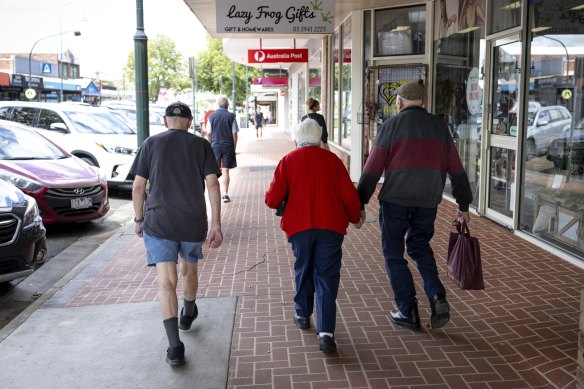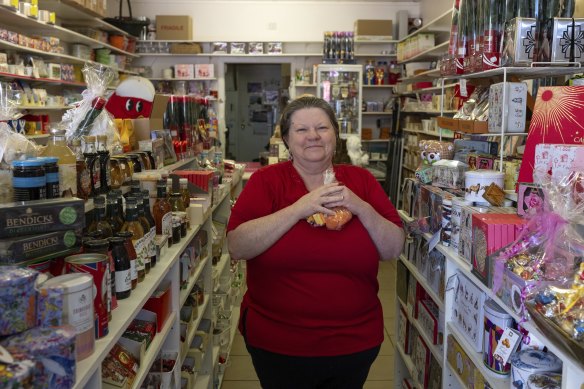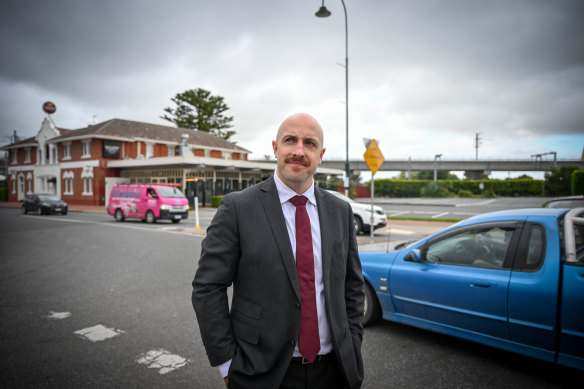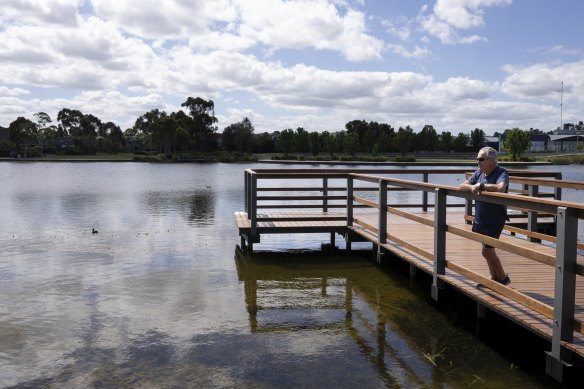By Najma Sambul
If you stand in the middle of Main Street in the old part of Pakenham, it could be any country town in Victoria.
Locals dawdle along the faux-brick footpaths and browse the offerings of boutique retailers selling knickknacks, gifts, lollies and candles while occasionally stopping to chat with a familiar face.

Pakenham in Melbourne’s south-east has transitioned from a small farming community to a mega-suburb in the past twenty years.Credit: Penny Stephens
At lunchtime, young tradies in fluoro vests covered in soot and bitumen residue from the nearby rail works walk in and out of a bakeshop with pies and energy drinks.
But a glance to the left and the quaintness of the town quickly disappears with the sight of Pakenham Central Marketplace – a large box shopping centre that would comfortably fit in a built-up inner-city suburb.
Over the past 20 years, Pakenham, which is about 55 kilometres from Melbourne’s CBD, has transitioned from a predominantly white country town to a multicultural mega-suburb where the local population has ballooned from 17,225 in 2000 to almost 55,000 in 2021, according to Australian Bureau of Statistics data. By 2041, 83,000 people are forecast to call Pakenham home.
The increase in housing stock has meant disruptive but necessary roadworks that will improve current traffic congestion for residents.

Leonie Thorne in her chocolate shop in Pakenham.Credit: Penny Stephens
If other Victorians are just starting to feel construction pain from the state government’s Big Build works, join the club, says local resident and business owner Leonie Thorne.
“We are just over it,” said Thorne, who has run The Chocolate Shop on Main Street, Pakenham, for the past 18 years. “Every road into Pakenham has got some sort of roadworks happening.”
The state government is currently upgrading two major roads at McGregor Road and Racecourse Road as well as level crossing removals at Racecourse Road, McGregor Road and Main Street. It is also building two new train stations at Pakenham, with the aim of reducing bottlenecks and improving traffic flow and connections to and from the Princes Freeway.
Cardinia Shire Council also has a 12-stage multimillion-dollar plan to upgrade the town centre’s “look and feel”, with wider footpaths, improved street lighting, parallel parking bays, more greenery, as well as murals and artworks in the laneways and arcades.
Thorne, who lives on the outskirts of Pakenham on a few acres of land with her ponies, said she had seen the suburb drastically change and neighbours move out because it had become “too built up”. Her worry is that the state government and local council have let Pakenham become too big, and its rural roots are being lost to sprawling housing developments and estates.
“I’m sorry to see old Pakenham go, you know. It was well, sort of, you know, a farming community,” Thorne said. “I suppose there’s green wedge zones and everything but there has to be a point where you’d be saying no more in this area.”
Urban sprawl and the Australian dream
When Cardinia Shire Council Mayor Jack Kowarzik first moved to Pakenham 20 years ago, like many residents, his family was in the pursuit of affordable housing and the Australian dream of owning a freestanding home with plenty of space.
“We were squeezed out of some of those inner Melbourne suburbs,” said 32-year-old Kowarzik, a plumber by trade.

Cardinia Shire Council Mayor Jack Korwarzik said the state government need to continue to invest in essential infrastructure like roads, schools and hospitals in Pakenham.Credit: Eddie Jim
In 2020, the state government greenlit plans for a new suburb within Pakenham — Pakenham East, which will have 7000 new homes, bring in thousands of new residents, and 1500 new jobs.
Last year, the Pakenham median house price was $630,000, according to Domain. The area has also become more culturally diverse with many young migrant families snapping up house-and-land packages. According to census data, the number of residents with both parents born overseas jumped to 33 per cent in 2022, up from 26.5 per cent in 2016.
Kowarzik, the former chair of the multicultural advisory group for Cardinia Shire Council, said Pakenham was establishing itself as a melting pot of cultures and the council was embracing the diversity. “It’s a great thing, and we love it,” he said.
However, the population boom more broadly was compounding the suburb’s already significant challenges of overdevelopment, a lack of infrastructure funding, and an imbalance of essential services such as hospitals and schools, Kowarzik said.
He also said the majority of the suburb’s residents left the suburb for work, forcing them to sit in traffic for hours each day. Pakenham does not have a hospital and construction for a Pakenham Community Hospital by the state government has previously encountered legal setbacks and is yet to begin.
“In Victoria, every township has a role to play, I think, in helping to resolve the housing crisis that we’ve seen. Because Pakenham has carried such a significant load, we would want to see development done in a very considered manner,” Kowarzik said.
He pointed to the state government’s 70/30 plan to contain Melbourne’s outward growth by building 70 per cent of all new homes in inner and middle ring suburbs, as a welcome relief but not a complete solution.
“We have to be realistic because we’ve experienced so much growth over the last 20 years. We’re already short on infrastructure and transport funding from that period of time. If the government is going to switch now, that’s fine, but we need that funding to keep coming through to make sure our community is supported and that Cardinia Shire is as livable as it possibly can be,” Kowarzik said
Prominent planning expert Dr Marcus Spiller, a partner at SGS Economics & Planning, agreed the state government needed to invest in growth suburbs. He said the planning of growth corridors where Pakenham was located made more sense in the 1980s when Victoria’s economy benefited from manufacturing.
“The economy back then had a much, much larger dependence on manufacturing and the jobs that go with manufacturing tended to be suburban and go out with the population. So for example, Dandenong back in the ’60s and ’70s was a high-income manufacturing base and good jobs were in that sector,” he said.
Now, the burgeoning greenfield suburbs have become “a social divide that is in the offing,” Spiller said.

Mike Zarb on the Lakeside jetty in PakenhamCredit: Penny Stephens
“At greenfield cities like Pakenham, there is constrained access to jobs, which creates an opportunity where people are more or less confined to living their lives in that orbit versus inner and middle established parts of Melbourne, where households have more life opportunities and can probably look forward to stronger housing asset price growth,” he said.
According to Victoria’s Department of Transport and Planning, Melbourne’s population will soar from 4.9 million to 6.4 million between 2021 and 2036, and 54 per cent of the growth will be concentrated in the city’s outer west, north and south-east.
Spiller also forecasts in a recent report from SGS that 1 million people – or 400,000 households – will still move into growth suburbs over the next three decades under the state government’s 70/30 model.
This means the state government still needs to heavily invest in infrastructure for growth suburbs, he said. Spiller also said the government should look into increasing job capacity by moving government jobs to such areas.
“Part of the problem with living there [in Pakenham] is that you have so few jobs available to you,” he said.
The future of the suburb
At a dazzling estate called Lakeside, Pakenham is at its best, says resident Mike Zarb. “You’ve got everything you need here, you don’t ever have to leave,” he said, pointing to the man-made lake.
Zarb, a retiree, bought into the estate four years ago from Rowville and was attracted by the easy living and slow pace of life in Pakenham.
“I just love it, the outdoors, the nature. I think the council even bring in fish every year into the lake so we can fish,” he said.
But like most people, he thinks there’s been enough growth outwards and doesn’t want to see the suburb overdeveloped.
The state government and Planning Minister Sonya Kilkenny have so far ruled out any changes to the urban growth boundary. Mayor Kowarzik said Cardinia Shire Council would not be supportive if that would ever become a point of contention.
“I don’t think advocating for expansion of the urban growth boundary is an appropriate thing and it’s not something that, as a council, we have even spoken about or advocated for,” he said.
“We have no plans to advocate for that because we have to be really conscious of the fact that some of our green wedge zones are some of the most beautiful parts of the world,” he said.
“In our Shire, we have Puffing Billy and Gumbuya World and all these sorts of beautiful rural areas, and businesses. We have a lot of productive farmland as well – Koo Wee Rup, Vervale, Iona.“
However, the reality is that greenfield suburbs like Pakenham are looking likely to be built all the way to the urban growth boundary, to meet the housing demand, said Spiller.
“There is land being actively planned for further expansion in that corridor, today, so it [development] is going to come to an end when the urban growth boundary is met, and that will be some time off because there’s still quite a bit of land within that boundary,” he said.
But for Korwazick, he understands the aspiration for homeownership that has brought residents flocking to Pakenham, just as his family once did.
“I certainly can’t begrudge anyone else doing the same thing,” he said.
Get the day’s breaking news, entertainment ideas and a long read to enjoy. Sign up to receive our Evening Edition newsletter here.